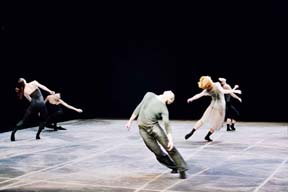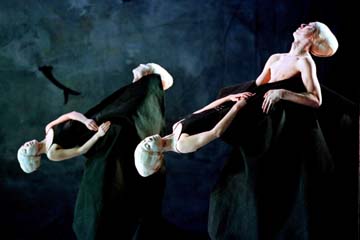|
The San Francisco Bay Area lucked in once again, thanks to the artistic director of Cal Performances, Robert Cole, who continues to discover brilliant performers from around the world and bring them to Berkeley before they are known in America. The latest discovery (after Cecilia Bartoli, Robert Wilson, Pina Bausch, Ian Bostridge, Robert Lepage, to name a few) is the 35-year-old Chinese choreographer Shen Wei with his company, Shen Wei Dance Arts.
Few choreographers have attempted to leave behind the classical story-line of Le Sacre du Printemps (The Rite of Spring) with its ritual sacrifice of a young virgin, and enter altogether new territory. There are many famous versions – for example Maurice Béjart´s in 1959, Pina Bausch´s in 1975, Angel Preljocaj´s in 2001 – and most of them make a clear reference to Nijinski´s original sacrificial ballet idea. Shen Wei´s Sacre is entirely different. He does not use the orchestral version of Stravinsky´s score that premiered with the Ballets Russes in 1913 in Paris and created the most famous scandal in music history – a public uproar that, according to Jean Cocteau, left Stravinsky, Diaghilev (who had commissioned the piece) and Nijinski "huddled together in the Bois de Boulogne, weeping". Shen Wei uses a four-hand piano version (which Paul Taylor also used for his story-telling version of Sacre), a recorded arrangement by only one pianist, Fazil Say. The piano score lacks the overwhelming heft of the orchestra piece and instead, sounds like the distilled, quasi spiritual essence of the composition. There is still all the excitement of the constant jagged rhythm changes, the powerful drive and the final thumping beat, but the listening experience is so different that I wondered at times if I was hearing the same piece.
With this reduced score there is no need for the usual massive groups of dancers to hold up against the musical onslaught. As if to mark the different intent, the small company of twelve dancers starts out in silence, in a slow ritual of coming on stage and taking a place, facing a direction, being still. But the moment the pianos start, the movement strikes with one explosive surprise after another. Single motion themes erupt with the musical themes like fireworks – acrobatic somersaults, quick, sharp fouetté-like beating of limbs, jagged hip and shoulder turns, leaps and spins that trigger chain reactions of centrifugal forces, set against abrupt islands of stillness. It is instantly clear that the movement arises from the same energetic core as the music, with no need to do anything more than embody this musical energy. It is also clear that all of this is in the command of a choreographer who is a spatial architect of surprising invention and mastery.
Shen Wei seems to be a "renaissance man" from the East: born in Hunan and trained in the  Chinese Opera from childhood, he is not only a great dancer, but also a painter, sculptor, designer and filmmaker. Dance making seems to be the medium that synchronizes his artistic sensitivities. " I wasn't taught the arts separately, so I don't separate them in my work," he says. (Interestingly, Stravinsky had originally devised the idea of a ballet scenario for Sacre together with his painter friend Nicholas Roerich.) Some of Shen Wei´s work was censored in China, but thanks to Western dance grants he was able to establish himself in New York in 1995 and create his new company, Shen Wei Dance Arts, in 2000. Having originally been inspired by a Western modern dance troupe touring in China, he seems to soak up the artistic currents of the West and deliver what he observes afresh, with the artistic capacity not just to imitate, but to transform everything into his own original vocabulary. Chinese Opera from childhood, he is not only a great dancer, but also a painter, sculptor, designer and filmmaker. Dance making seems to be the medium that synchronizes his artistic sensitivities. " I wasn't taught the arts separately, so I don't separate them in my work," he says. (Interestingly, Stravinsky had originally devised the idea of a ballet scenario for Sacre together with his painter friend Nicholas Roerich.) Some of Shen Wei´s work was censored in China, but thanks to Western dance grants he was able to establish himself in New York in 1995 and create his new company, Shen Wei Dance Arts, in 2000. Having originally been inspired by a Western modern dance troupe touring in China, he seems to soak up the artistic currents of the West and deliver what he observes afresh, with the artistic capacity not just to imitate, but to transform everything into his own original vocabulary.
In his Sacre, his dancers sometimes seem to embody brushes that paint the music in a mesmerizing calligraphy onto the stage.
 |
I was struck by the technical and stylistic cohesion of the twelve dancers, bringing to mind the severely trained artists of Chinese Opera or, in the West, the unity of the New York City Ballet at the time of Balanchine's brilliant dictatorship. However, faithful to modern dance's credo, each dancer showed a distinctive personality of body expression, especially Shen Wei himself whose hands and wrists gave even the most jagged movements a feminine touch. The twelve were also bound together by the strict harmony of Shen Wei´s design: grey and black tights and pants, painted tunics, skull caps, greyish-white painted skin. (The strangely "floating" dance floor is a geometric painting by Shen Wei in the same tonalities.) The facial paint serves as a mask, Shen Wei explains, in order to create an other-worldly effectand mute the dancer's emotional reactions to the music: "We aren't telling a story. This is about the music's structure."
The structural strictness and technical cohesion at times reminded me of the German painter and choreographer Oskar Schlemmer ("Triadisches Ballett") and his concepts of the geometrical laws of movement. But playfulness was a consistent element in the way that one can think, for example, of a Bach fugue as playful. In a twist on the lead dancer of the original Sacre ("The Chosen One"), one woman danced in a fluid dress contrasting with the tight attire of the eleven others. Her hair in an exquisitely muted golden bob cut was the single color in the piece. There were comical touches: movements that made burlesque allusions to Mats Ek; running and childlike crawling seemingly right out of Pina Bausch; there was the spice of Balanchine's disjointed hip swings and flexed feet; there was the bent-back stomping that for seconds brought back the original folkloristic Russian inspiration of Nijinski´s choreography. Shen Wei´s choreography held the tension between occupied space and negative space and between concentrical and exploding movements of ensembles, quartets, trios or solos, without ever falling into chaoticness or haste. His Sacre had a timeless core of stillness and at the same time a breathless excitement that perfectly met Stravinski´s music. Shen Wei is obviously musically gifted to an unusual degree. When American critics write that Mark Morris is the most musical of all choreographers (The New York Times), I want to say, "Look again!"
Shen Wei´s Sacre premiered at the American Dance Festival in 2002. Dance critic Anna Kisselgoff called it "an instant classic." "It is hard to recall anyone else," she wrote, "who has responded to the music with such striking, stripped-to-the-bone abstraction as Mr. Shen has."
After this bravura piece, it was hard to imagine how the second half of the evening would hold up by comparison. But instead of faltering, the second piece, "Folding", was as powerful, if not even more spectacular. It was created for the Guandong Modern Dance Company during a rare return visit of Shen Wei to China, in 2000. It is a mysterious tale with a far Eastern touch, apparently based on "feelings about the single action of folding – be it paper, fabric, flesh or other". Set to Tibetan chanting and the dream-like music of John Tavernier, "Folding" may be Shen Wei´s homage to the Paris-based Butoh dance theater troupe Sankai Juku. Strange painterly rituals are being performed in front of a huge 18th century Chinese watercolor showing a few fish in empty space.
The twelve dancers, with seemingly naked, white-painted torsos, their breasts bound with bandages that look like strange corsets, are wearing flamboyant scarlet ball-gown skirts – a striking reminder of Sankai Juku´s naked torsos and gender-crossing saddled skirts. No monk-like bald heads here; instead, Shen Wei has designed a cone-shaped phallic head dress with a mother-of-pearl shimmer. The dancers enter in pairs from stage right and left, dragging their spectacular skirts across the stage in large arcs, meeting up in the center and disappearing in opposite directions as another pair enters. They move in an Asian stage walking technique as if rolling on skates, a technique as amazing as the imperceptible, fast-forward movement on point of a ballerina ("pas de bourrée couru"), only here the walking is done on flat feet with slightly bent knees. The extraordinary speed and fluidity of these circular pairs creates the effect of luscious red paint poured onto blotting paper. There is a childish joy in seeing something so basic as speed-walking in such an implausible perfection, repeated over and over in new variations of arcs: the effect is comical and breathtakingly beautiful at the same time.
The same mix of implausible and comical beauty continues when the Tibetan chants melt into Tavernier´s chiming music and a series of couples in black skirts appears.
The women with their phallic heads are riding frontally on the male bodies like fixed appendixes or rigid additional limbs, arising from the folds of the men's skirts and sometimes slowly descending downwards. It is impossible to know what one is looking at while these merged couples cross the stage in a very slow ritual procession, flooded by light. Are we watching the walking meditation of a cone-headed couples cult? The display of trophy wives joined at the hip to their providers? The strange mating rituals of stick insects?An evolved race that has left sex behind and uses human pruning? While the surreal black procession continues, some of the creatures in red with their wind-up-toy speed reappear in attitudes of deep concentration, meditative searching or ecstasy as they draw their vivid color arcs between the couples.
Finally, the red group hovers in a crepuscular light at center stage like a bunch of peonies suspended on trembling water, while Shen Wei dances a Butoh-inspired solo at the left front.
He never leaves his spot; the dance is all in the minuscule shifts of muscle tensions and highly expressive energies flowing in slow motion through his torso, neck, arms and hands. As the lights dim on him, the shivering red group recedes into the background and slowly, in an eerie fading light, seems to turn into pulsating red sticks topped by whitish shimmering dots – a group of extra-terrestrial beings made of pure energy who seem to slowly levitate out of view.
Once again, the body control and cohesion of the group, the spatial composition, the mystery and beauty of the choreography and lighting were admirable. The impression of seeing something entirely new made from familiar elements was fascinating. "My work isn't about real life," Shen Wei concluded in a talk with the audience, "or about being Eastern or Western. I'm exploring the unknown."
|

